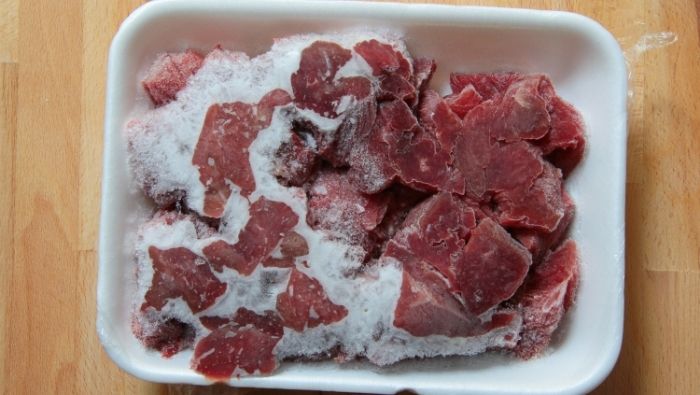How To Prevent Freezer Burn

When you have to toss freezer-burnt food, it is the same as tossing your hard-earned cash. Take these steps to prevent freezer burn and protect your frozen assets.
We’ve all done it.
You pull some meat or a leftover casserole out of the freezer, unwrap it, and it just doesn’t look right. Your meat has turned grey, or the casserole is encased in ice crystals.
What you have is called freezer burn, and it is a result of food not being properly wrapped or left too long in the freezer.
Let’s explore what causes freezer burn and what you can do to prevent it.
What Causes Freezer Burn?
Freezer burn is caused by air being allowed to circulate around the food removing the moisture. This, in turn, dries out the food or the moisture re-freezes on the surface of the food.
This process is worse than it once was, because modern “frost-free” refrigerators suck the moisture out of the air, and as a by-product, your food.
Can Eating Freezer-Burnt Food Make You Sick?
Freezer burn isn’t harmful, but the tough dried-out texture of meat, or the mushy, tasteless result of the ice crystals, makes it wasteful. After all, you froze the food to save money and stretch your food budget. If you end up throwing it out due to freezer burn, you have wasted time and money.
Sign Up for Savings
Subscribe to get money-saving content by email that can help you stretch your dollars further.
Twice each week, you'll receive articles and tips that can help you free up and keep more of your hard-earned money, even on the tightest of budgets.
We respect your privacy. Unsubscribe at any time.
How Do You Prevent Freezer Burn?
Seal it. Keep the moisture in and keep fresh air out. Begin by making sure there is as little air as possible in the storage container.
How To Properly Seal and Freeze Meats From the Grocer
If you are buying and storing meat from a market, it will depend on how it is packaged. The standard plastic-wrapped plastic tray is sealed, but there is a lot of air in there. Remove the meat from the store container. If you have bought large portions, now is a good time to separate it into servings or meals.
Wrap the pieces tightly in plastic wrap, molding and fitting them so there is as little air as possible between the wrapping and the meat. Use freezer tape, if necessary, to seal it.
Now place these wrapped pieces into a sealable plastic bag. Push as much air out as possible, then seal the bag almost closed.
Now push any remaining air out and hold the bag in close to the meat while you finish the seal. This will create a bit of a vacuum to prevent air from getting in or out.
Label and date the meat and store it in your freezer.
How To Properly Seal and Freeze Meats From a Butcher
If you bought the meat from a butcher, chances are it was put in a plastic bag and then wrapped with paper. The act of wrapping the bag with the paper forced most of the air out of the bag, and the paper was taped tightly around it.
Go ahead and leave this wrapped as is, and then follow the same procedure for placing the meat into a plastic bag.
Related: 10 Ways To Save on Meat and Poultry
How To Properly Seal and Freeze Leftovers
If you are storing leftovers or a casserole, don’t just put it in a plastic container. Even though these containers are sealed, there is a lot of air left inside to cause freezer burn.
If the food is not too messy, first wrap it in plastic as you would the meat before placing it in the plastic tub or box. If it is too messy to wrap, go ahead and freeze it in the container. As soon as it is frozen, pop it out, wrap the frozen block in plastic, and then reseal it.
With a little planning and a few minutes, freezer burn can be minimized or eliminated. This will save you time and money, and make those leftovers taste almost as good as the day they were cooked.
Just remember to date everything. No matter how well it is wrapped, time is the enemy and eventually, freezer burn will win out.
Reviewed October 2023
Wouldn't you like to be a Stretcher too?
Subscribe to get our money-saving content twice per week by email and start living better for less.
We respect your privacy. Unsubscribe at any time.
Popular Articles
On After50Finances.com
- 9 Things You Need to Do Before You Retire
- You Didn’t Save Enough for Retirement and You’re 55+
- When Empty Nesters Reorganize and Declutter Their Home
- Reinventing Your Career in Your 50s or 60s
- What Mature Homeowners Should Know about Reverse Mortgages
- 2 Reasons to Collect Social Security Benefits As Soon As Possible


